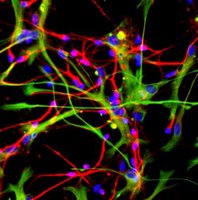Neuroindices of Memory Capacity
 Direct relationships between neuroimaging and measures of "intelligence" (broadly speaking) have until now mostly been the stuff of science fiction. Many of the cognitive functions considered integral to our capacity for intelligent behavior are thought to be an emergent property of oscillations between far-flung brain regions; functions like "attention" or "working memory" seem to involve these complex interactions between multiple brain regions on multiple timescales. Not surprisingly, this makes the functions rather difficult to localize, and given the spatiotemporal tradeoffs inherent to neuroimaging methods, links between neuroimaging and specific cognitive indexes are rare.
Direct relationships between neuroimaging and measures of "intelligence" (broadly speaking) have until now mostly been the stuff of science fiction. Many of the cognitive functions considered integral to our capacity for intelligent behavior are thought to be an emergent property of oscillations between far-flung brain regions; functions like "attention" or "working memory" seem to involve these complex interactions between multiple brain regions on multiple timescales. Not surprisingly, this makes the functions rather difficult to localize, and given the spatiotemporal tradeoffs inherent to neuroimaging methods, links between neuroimaging and specific cognitive indexes are rare. However, Vogel and Machizawa (2004) have found a startlingly accurate ERP correlate of encoding and maintenance in visual short term memory. By using a simple calculation, they are capable of predicting an individual's visual short term memory capacity (the ability to remember objects with multiple features over a delay in the range of seconds to minutes).
The ERP component reflecting these capacity limits is recorded from the posterior parietal and lateral occipital electrode sites, and consists of a single positive spike which sustains its activity over the delay period. For most people, this wave reaches an asymptotic minimum when around 4 items are being successfully maintained (as measured by subsequent recall). For lower capacity individuals, this wave reaches its minimum more quickly, such that it may be "as low as it will go" when only 2 or 3 items are being maintained.
The authors discovered this component first by presenting visual items to participants in only one visual hemifield. Next, the participants were required to maintain these items over a delay, and then respond to whether a test delay was the same or different, while an EEG was recorded from their scalp. By subtracting the ipsilateral wave from the wave in the hemisphere contralateral to the to-be-remembered hemifield (so as to find the component related only to the remembered items), and then by analyzing the amount of change between the encoding of successive items, the researchers can forecast the number of visual items at which this wave would asymptote, reflecting nearly 78% of the variability in that individual's visual short term memory capacity (p<0.0001).
Other conditions ruled out alternative interpretations of this calculation as a result of simply increasing the number of maintained representations, changes in arousal, more executive processing, or higher difficulty overall. However, the active maintenance of items in visual memory does suggest that the recorded EEG is actually a product of visual short term memory under the influence of amplification by attention.
What is the mechanism by which this "wave" or attentional modulation might be more thinly spread among representations in low capacity individuals than in high capacity individuals? One possibility is that a second "gating" frequency is responsible for allocating the attentional modulation among items, and that the gating frequency differs among individuals such that some can successfully allocate their available attentional bandwidth to more items than others. Or, the frequency of attentional maintenance itself could be lower in these individuals, reflecting lower bandwidth. Unfortunately, both interpretations are probably naively simplistic, given that changes to one frequency would likely result in concomitant adjustments in others. Until the origins, pathways, and purposes of such oscillations can be untangled, this highly accurate neuroindex of memory capacity will continue to be somewhat perplexing.
Related Posts:
Entangled Oscillations (and possible roles of various frequencies in gating)
Active Maintenance and the Visual Refresh Rate (and gating between modalities in working memory)
Thinking about "Thinking Harder" (and a neuroindex of cognitive workload)
Anticipation and Synchronization (and results consistent with a relatively slow gating of fast "attentional" gamma oscillations)


2 Comments:
There are some factors here which probably affect visual memory. During the memorisation period how many times do the eyes saccade, and how many targets appear inside the 20 degree field of vision of the fovea?
Ahhh, Bob - always the skeptic :) But I'm glad we have you around.
Any trial in which blinks, or saccades greater than 1 degree occurred, were thrown out.
All stimulus arrays were presented in one of two rectangular region 4 degrees x 7.3 degrees. These were centered 3 degrees to the left or right of a central fixation cross.
Each memory array consisted of between 1-10 colored squares, stimulus positions were randomized within each hemifield with the constraint that center-to-center separation between any two squares had to be at least 2 degrees.
Personally, I think they did a good job here, and if this is just an artifact, I don't see why one group would do it more than the other group...
Post a Comment
<< Home